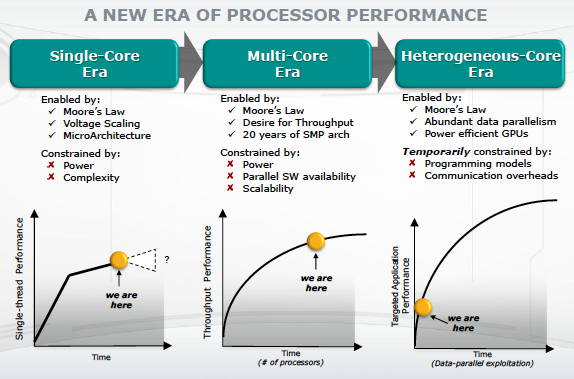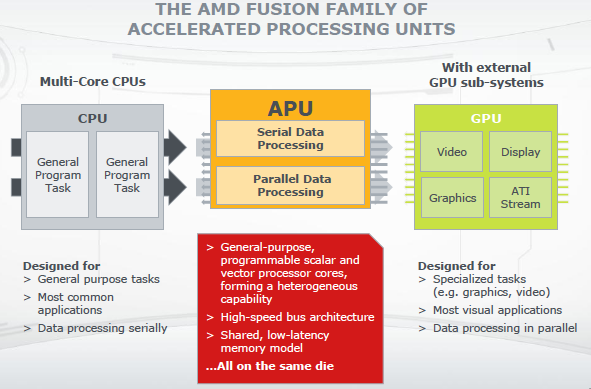AMD Fusion: Brazos Gets Previewed: Part 1
Today is AMD’s 2010 Financial Analyst Day, and we have some more details on its Fusion APUs. Llano is still a few months away. In the meantime, we have a preview of the Brazos platform, which will voraciously tackle mobility under the $500 price point.
AMD Fusion: What Can It Do?
If you haven’t yet seen our earlier coverage of AMD’s 2011 Code Names, its a good time to play some catch-up.
Fusion: AMD is using the word Fusion to describe an approach to processor design and software development, in its words: “…delivering powerful CPU and GPU capabilities for HD, 3D, and data-intensive workloads in a single-die processor called an APU (accelerated processing unit). APUs combine high-performance serial and parallel processing cores with other special-purpose hardware accelerators, enabling breakthroughs in visual computing, security, performance-per-watt and device form factor.”
In short, an APU designed according to AMD’s Fusion initiative will include a CPU and a GPU on a single piece of silicon. The improvements an APU are supposedly going to deliver include enhanced mainstream gaming performance and accelerated video transcoding, to name a couple of specific examples.
Fusion is the culmination of the AMD and ATI merger. AMD sees this as the next step in processor design as we near the apogee of the “Multi-Core Era.”
Remember that any system is only as fast as its slowest link. This means computational bottlenecks are always going to be a mix of bandwidth and latency. AMD considers its APU a Heterogenous Processing Unit, since it introduces a massive SIMD GPU array that allows general use programmable scalar and vector processor cores. This means that, while the GPU consumes the greatest real estate on the die, APUs will benefit from parallel processing capabilities particularly, as the shared memory helps enable lower latencies that integrated graphics processors have never enjoyed.
Discrete GPU solutions clearly still have their place, but APUs will still offer a big boost to value-oriented customers compared to anything seen from AMD before.
The real question becomes: how can Fusion speed up everyday tasks? Even if the processor cores are on par with what we see today, what can that on-die GPU do? We had a discussion with Tom Vaughan, CyberLink’s director of business development about this very issue. His company's software is quite often at the forefront of supporting brand new hardware technologies. Looking to the future, CyberLink sees a time when the capabilities of an APU and a discrete graphics solution are additive through an API like OpenCL. For example, if you have an APU with 400 stream processors and an add-in card with 1600, there could be gains tied to using them cooperatively. Or say you're running your display from the on-die graphics, and only spinning up the discrete card when a 3D application needs it. There might be power-oriented benefits there.
Get Tom's Hardware's best news and in-depth reviews, straight to your inbox.
More immediately, though, you should be able to operate an APU and see near-identical performance to a comparable CPU/discrete graphics solution. Taking the PCI Express bus out of the equation does cut down on some latencies, but you'd be hard-pressed to tell either configuration apart. The real gain stems from the integration. Putting one more (capable) subsystem into the processor eliminates a discrete card, which in turn cuts back on cost, power, and motherboard complexity. This is really about doing the same job for less money than it would have cost previously. Surely, that's one of AMD's hallmarks.
In the past, the integration of graphics was a value-add that companies like Intel tried to sugarcoat. The reality was that only a subset of its customers could use the built-in graphics. Everyone else needed an add-in chip from a vendor like AMD or Nvidia. And when it comes to mobility, we all know what building with a discrete GPU does to cost. Now, integrated graphics is relevant to a far larger customer base. There is still a point where an add-in chip becomes necessary to support the habits of a more hardcore user. But that threshold shift to the right, as the diagram below illustrates. Atom cannot achieve that today.
Even though we are only looking at Brazos today (it’s a mainstream value platform), there are very clear performance benefits associated with optimizing for an architecture designed under Fusion's charter. When we get to look at Sabine and Lynx, things will look at lot more exciting, and the benefits of a beefier APU will become clearer. We’ll talk more about Sabine and Lynx soon enough, but today is, again, about Brazos.
Current page: AMD Fusion: What Can It Do?
Prev Page The AMD And Intel Tug Of War Next Page AMD Fusion: Brazos Platform-
bombat1994 awesome to see amd get into the netbook centre, finally show the public how badly the atom is clock for clockReply -
Interesting to see them projecting an increased market in netbooks given all the high profile remarks about Tablets supposedly cannibalizing it.Reply
-
acku Tablets get us into a whole other portion of the debate, as we need to start also talk about demographics. The short version of the conversation - keep in mind that a cannibalized market doesn't necessarily mean a decrease in the volume. It generally translates into a slow down in growth and a smaller proportional market.Reply
Cheers,
Andrew Ku
TomsHardware.com -
joytech22 AMD has and always will kick Intel's ass in the IGP market (excuse the rude but necessary language)Reply
Well, at least that's what i think, probably going to get downed a bit. -
compton The more the merrier. My hope is that AMD can leverage this launch into a successful campaign, then bring more competitive desktop solutions to people like me, looking at my Phenom II, then looking at the Intel 32nm core i3 that can meet or beat it... and gets worse from there. If Brazos doesn't do so hot, AMD's gonna need some serious tricks (like a miracle) to bring the heat to Intel. My Phenom II is pretty good stacked against the Core 2 but its almost 2011. Bring the funk AMD! Or let me know if you decide to... well, not. I'm ready for it now.Reply -
dEAne While AMD cannot go straight with intel in big CPU battles he makes little ones like david to bite it's toes to make intel preoccupied until bulldozer arrives.Reply -
super_tycoon Trust me, I've tried playing dirt2 on a ultra-thin and you get miso soup for graphics. A kind of foggy, blurry slurry; it's not something you really want to be associated with.Reply -
SteelCity1981 If the Graphics Core is based on the Evergreen architecture then why not just call it Radeon 5250 and 5310 series? It's just confusing to the consumor standpoint to call a Radeon GPU a 6250 and a 6310 when it's based on the Radeon 5 series. Especially considering there will be no new Radeon 6 series that will come out lower then the 6800 series.Reply -
lunyone Let's see my wishlist in a netbook or equivalent:Reply
* Decent battery life (if needed for plane trips) *possibly??
* Around 15" screen (I like this size, 10" seems too small for me) *possibly??
* Be able to play HD (whether online or off a DVD) *sounds like a good possibly??
* Be able to play most recent games on (even low settings is fine) *possibly??
*



